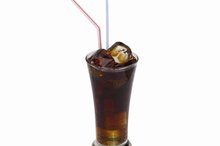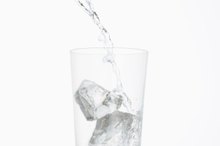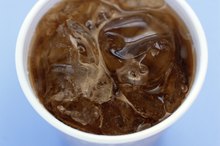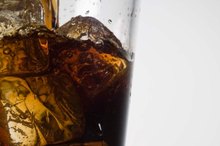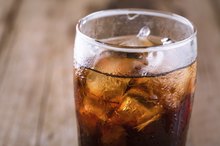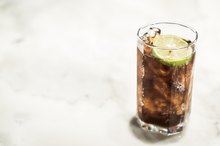What does fact checked mean?
At Healthfully, we strive to deliver objective content that is accurate and up-to-date. Our team periodically reviews articles in order to ensure content quality. The sources cited below consist of evidence from peer-reviewed journals, prominent medical organizations, academic associations, and government data.
- Harvard School of Public Health: Sugary Drinks and Obesity Fact Sheet
- Circulation: Sweetened Beverage Consumption, Incident Coronary Heart Disease, and Biomarkers of Risk in Men
- Circulation: Sweetened Beverage Consumption, Incident Coronary Heart Disease, and Biomarkers of Risk in Men
- Diabetes Care: Sugar-Sweetened Beverages and Risk of Metabolic Syndrome and Type 2 Diabetes: A Meta-Analysis
- Diabetes Care: Sugar-Sweetened Beverages and Risk of Metabolic Syndrome and Type 2 Diabetes: A Meta-Analysis
- Journal of the American Medical Association: Fructose-Risk Beverages and Risk of Gout in Women
- Journal of the American Medical Association: Fructose-Risk Beverages and Risk of Gout in Women
The information contained on this site is for informational purposes only, and should not be used as a substitute for the advice of a professional health care provider. Please check with the appropriate physician regarding health questions and concerns. Although we strive to deliver accurate and up-to-date information, no guarantee to that effect is made.
The Disadvantages of Soft Drinks
Before the 1950s, 6.5 ounces was the standard size for soda bottles. Now 20-ounce bottles are standard, but even larger 42-ounce bottles are available, meaning soft drink consumption continues to rise. According to an article published in 2011 in “Preventive Medicine,” in 2009, the average American consumed 31 gallons of regular soft drinks. The calories from the beverages are empty calories with no nutritional value. An occasional soda isn’t going to harm you, but drinking too much may lead to weight gain and health problems.
If you are experiencing serious medical symptoms, seek emergency treatment immediately.
Weight Gain
Harvard University states that the increased consumption of sugary beverages, such as soda, is a major factor in the growing obesity epidemic. A 20-ounce soda contains 240 calories while a 64-ounce soft drink contains a whopping 700 calories. Dr. Christopher Ochner, assistant professor of pediatric and adolescent medicine at the Icahn School of Medicine at Mount Sinai, told Fox News that if you drink a can of cola every day, you will gain 14 1/2 pounds in a year. Excessive weight gain puts you at risk for diabetes, certain cancers, arthritis, heart disease and stroke.
- Harvard University states that the increased consumption of sugary beverages, such as soda, is a major factor in the growing obesity epidemic.
Heart Disease
Health Dangers of Drinking Soda
Learn More
Excessive weight gain contributes to heart disease, but so too do the ingredients in soda. Dr. Mary Ann McLaughlin, medical director of the cardiac health program at Mount Sinai, told Fox News that the sodium and caffeine in soft drinks put your heart at risk. Sodium causes you to retain fluid and caffeine elevates your heart rate and blood pressure. An analysis published in 2012 in “Circulation” followed more than 42,000 men and discovered those who drank one sugary drink a day had an increased risk of heart attack compared to those who rarely or never drank sugary beverages.
- Excessive weight gain contributes to heart disease, but so too do the ingredients in soda.
- An analysis published in 2012 in “Circulation” followed more than 42,000 men and discovered those who drank one sugary drink a day had an increased risk of heart attack compared to those who rarely or never drank sugary beverages.
Diabetes
Most people have a hard time eating just one cookie and that’s because sugar is addictive. If you drink a soft drink, your blood sugar spikes and your body produces insulin to balance that spike. Your blood sugar then crashes and you seek out more sugar-filled soda to compensate. Over time, your body becomes resistant to insulin leaving you unable to metabolize sugar and resulting in diabetes, according to Dr. Ochner. If you drink one to two soft drinks a day, you increase your risk of Type 2 diabetes by 26 percent, according to a meta-analysis published in 2010 in "Diabetes Care."
- Most people have a hard time eating just one cookie and that’s because sugar is addictive.
- If you drink a soft drink, your blood sugar spikes and your body produces insulin to balance that spike.
Dental Problems
What Effects Does Coke Have on Teeth?
Learn More
If you prefer to avoid the dentist, cut back on soft drinks. The bacteria in your mouth thrive on sugar. They feed on it and produce an acid that wears away your teeth enamel causing cavities. New Jersey Dentist Dr. Howard Glazer told “Better Homes and Garden” you can cut your cavity risk in half by rinsing your mouth with water immediately after drinking soda.
- If you prefer to avoid the dentist, cut back on soft drinks.
- They feed on it and produce an acid that wears away your teeth enamel causing cavities.
Gout
Gout is a condition in which your body has too much uric acid, causing your joints to become swollen and inflamed. An analysis of data from the Nurses' Health Study, published in 2010 in the “Journal of the American Medical Association,” which followed almost 80,000 women for 22 years, reported that women who drank one sugary beverage a day had a significantly increased risk of gout compared to those who rarely drank sugary beverages 6.
Related Articles
References
- Harvard School of Public Health: Sugary Drinks and Obesity Fact Sheet
- Preventive Medicine: Estimating the Potential of Taxes on Sugar-Sweetened Beverages to Reduce Consumption and Generate Revenue
- Fox News: Soda: Public Health Enemy Number One?
- Circulation: Sweetened Beverage Consumption, Incident Coronary Heart Disease, and Biomarkers of Risk in Men
- Diabetes Care: Sugar-Sweetened Beverages and Risk of Metabolic Syndrome and Type 2 Diabetes: A Meta-Analysis
- Journal of the American Medical Association: Fructose-Risk Beverages and Risk of Gout in Women
- Coca-Cola Bottle, 12 fl oz. U.S. Department of Agriculture. Published February 27, 2020.
- 2015-2020 Dietary Guidelines for Americans. U.S. Department of Health and Human Services.
- How much sugar is too much? American Heart Association.
- Freeman CR, Zehra A, Ramirez V, Wiers CE, Volkow ND, Wang GJ. Impact of sugar on the body, brain, and behavior. Front Biosci (Landmark Ed). 2018;23:2255-2266. Published 2018 Jun 1.
- Pasiakos SM, McLellan TM, Lieberman HR. The effects of protein supplements on muscle mass, strength, and aerobic and anaerobic power in healthy adults: a systematic review. Sports Med. 2015;45(1):111-131. doi:10.1007/s40279-014-0242-2
- Blom WA, Lluch A, Stafleu A, et al. Effect of a high-protein breakfast on the postprandial ghrelin response. Am J Clin Nutr. 2006;83(2):211-220. doi:10.1093/ajcn/83.2.211
- Tipton KD. Nutritional Support for Exercise-Induced Injuries. Sports Med. 2015;45 Suppl 1:S93-S104. doi:10.1007/s40279-015-0398-4
- Kerstetter JE, Kenny AM, Insogna KL. Dietary protein and skeletal health: a review of recent human research. Curr Opin Lipidol. 2011;22(1):16-20. doi:10.1097/MOL.0b013e3283419441
- Paddon-Jones D, Short KR, Campbell WW, Volpi E, Wolfe RR. Role of dietary protein in the sarcopenia of aging. Am J Clin Nutr. 2008 May;87(5):1562S-1566S. doi: 10.1093/ajcn/87.5.1562S. PMID: 18469288.
- Maughan RJ, Griffin J. Caffeine ingestion and fluid balance: a review. J Hum Nutr Diet. 2003 Dec;16(6):411-20. doi: 10.1046/j.1365-277x.2003.00477.x. PMID: 19774754.
- Lete I, Allué J. The Effectiveness of Ginger in the Prevention of Nausea and Vomiting during Pregnancy and Chemotherapy. Integr Med Insights. 2016;11:11-17. Published 2016 Mar 31. doi:10.4137/IMI.S36273
- Laura Helm, Ian A. Macdonald, Impact of beverage intake on metabolic and cardiovascular health, Nutrition Reviews, Volume 73, Issue suppl_2, 1 September 2015, Pages 120–129, https://doi.org/10.1093/nutrit/nuv049
- Ma J, Jacques PF, Meigs JB, et al. Sugar-Sweetened Beverage but Not Diet Soda Consumption Is Positively Associated with Progression of Insulin Resistance and Prediabetes. J Nutr. 2016;146(12):2544-2550. doi:10.3945/jn.116.234047
- Rippe JM, Angelopoulos TJ. Relationship between Added Sugars Consumption and Chronic Disease Risk Factors: Current Understanding. Nutrients. 2016;8(11):697. Published 2016 Nov 4. doi:10.3390/nu8110697
- Bucher Della Torre S, Keller A, Laure Depeyre J, Kruseman M. Sugar-Sweetened Beverages and Obesity Risk in Children and Adolescents: A Systematic Analysis on How Methodological Quality May Influence Conclusions. J Acad Nutr Diet. 2016;116(4):638-659. doi:10.1016/j.jand.2015.05.020
- Bray GA, Nielsen SJ, Popkin BM. Consumption of high-fructose corn syrup in beverages may play a role in the epidemic of obesity [published correction appears in Am J Clin Nutr. 2004 Oct;80(4):1090]. Am J Clin Nutr. 2004;79(4):537-543. doi:10.1093/ajcn/79.4.537
- Vartanian LR, Schwartz MB, Brownell KD. Effects of soft drink consumption on nutrition and health: a systematic review and meta-analysis. Am J Public Health. 2007;97(4):667-675. doi:10.2105/AJPH.2005.083782
- Pollock NK, Bundy V, Kanto W, et al. Greater fructose consumption is associated with cardiometabolic risk markers and visceral adiposity in adolescents [published correction appears in J Nutr. 2013 Jan;143(1):123]. J Nutr. 2012;142(2):251-257. doi:10.3945/jn.111.150219
- Elffers TW, de Mutsert R, Lamb HJ, et al. Body fat distribution, in particular visceral fat, is associated with cardiometabolic risk factors in obese women. PLoS One. 2017;12(9):e0185403. Published 2017 Sep 28. doi:10.1371/journal.pone.0185403
- Yudkin J. Sugar and ischaemic heart disease. Practitioner. 1967;198(187):680-683.
- Liu S, Willett WC, Stampfer MJ, et al. A prospective study of dietary glycemic load, carbohydrate intake, and risk of coronary heart disease in US women. Am J Clin Nutr. 2000;71(6):1455-1461. doi:10.1093/ajcn/71.6.1455
- Cohen L, Curhan G, Forman J. Association of sweetened beverage intake with incident hypertension. J Gen Intern Med. 2012;27(9):1127-1134. doi:10.1007/s11606-012-2069-6
- Welsh JA, Sharma A, Cunningham SA, Vos MB. Consumption of added sugars and indicators of cardiovascular disease risk among US adolescents. Circulation. 2011;123(3):249-257. doi:10.1161/CIRCULATIONAHA.110.972166
- Assy N, Nasser G, Kamayse I, et al. Soft drink consumption linked with fatty liver in the absence of traditional risk factors. Can J Gastroenterol. 2008;22(10):811-816. doi:10.1155/2008/810961
- Jiantao Ma, Caroline S. Fox, Paul F. Jacques, Elizabeth K. Speliotes, Udo Hoffmann, Caren E. Smith, Edward Saltzman, Nicola M. McKeown,Sugar-sweetened beverage, diet soda, and fatty liver disease in the Framingham Heart Study cohorts. Journal of Hepatology 63;2(2015). https://doi.org/10.1016/j.jhep.2015.03.032.
- Avena NM, Bocarsly ME, Hoebel BG. Animal models of sugar and fat bingeing: relationship to food addiction and increased body weight. Methods Mol Biol. 2012;829:351-365. doi:10.1007/978-1-61779-458-2_23
- Avena NM, Rada P, Hoebel BG. Evidence for sugar addiction: behavioral and neurochemical effects of intermittent, excessive sugar intake. Neurosci Biobehav Rev. 2008;32(1):20-39. doi:10.1016/j.neubiorev.2007.04.019
- Choi HK, Willett W, Curhan G. Fructose-rich beverages and risk of gout in women. JAMA. 2010;304(20):2270-2278. doi:10.1001/jama.2010.1638
- Choi HK, Curhan G. Soft drinks, fructose consumption, and the risk of gout in men: prospective cohort study. BMJ. 2008;336(7639):309-312. doi:10.1136/bmj.39449.819271.BE
- Jamnik J, Rehman S, Blanco Mejia S, et al. Fructose intake and risk of gout and hyperuricemia: a systematic review and meta-analysis of prospective cohort studies. BMJ Open. 2016;6(10):e013191. Published 2016 Oct 3. doi:10.1136/bmjopen-2016-013191
- Tooth. American Dental Association. https://www.mouthhealthy.org/en/az-topics/t/tooth.
- Cheng R, Yang H, Shao MY, Hu T, Zhou XD. Dental erosion and severe tooth decay related to soft drinks: a case report and literature review. J Zhejiang Univ Sci B. 2009;10(5):395-399. doi:10.1631/jzus.B0820245
- Hanover LM, White JS. Manufacturing, composition, and applications of fructose. Am J Clin Nutr. 1993;58(5 Suppl):724S-732S. doi:10.1093/ajcn/58.5.724S
- Meghan B. Azad, Ahmed M. Abou-Setta, Bhupendrasinh F. Chauhan, et al. Nonnutritive sweeteners and cardiometabolic health: a systematic review and meta-analysis of randomized controlled trials and prospective cohort studies. CMAJ Jul 2017, 189 (28) E929-E939; DOI: 10.1503/cmaj.161390
- Fowler, S.P., Williams, K., Resendez, R.G., Hunt, K.J., Hazuda, H.P. and Stern, M.P. (2008), Fueling the Obesity Epidemic? Artificially Sweetened Beverage Use and Long‐term Weight Gain. Obesity, 16: 1894-1900. doi:10.1038/oby.2008.284
- Fowler SP, Williams K, Hazuda HP. Diet soda intake is associated with long-term increases in waist circumference in a biethnic cohort of older adults: the San Antonio Longitudinal Study of Aging. J Am Geriatr Soc. 2015;63(4):708-715. doi:10.1111/jgs.13376
Writer Bio
Michelle Fisk began writing professionally in 2011. She has been published in the "Physician and Sports Medicine Journal." Her expertise lies in the fields of exercise physiology and nutrition. Fisk holds a Master of Science in kinesiology from Marywood University.

